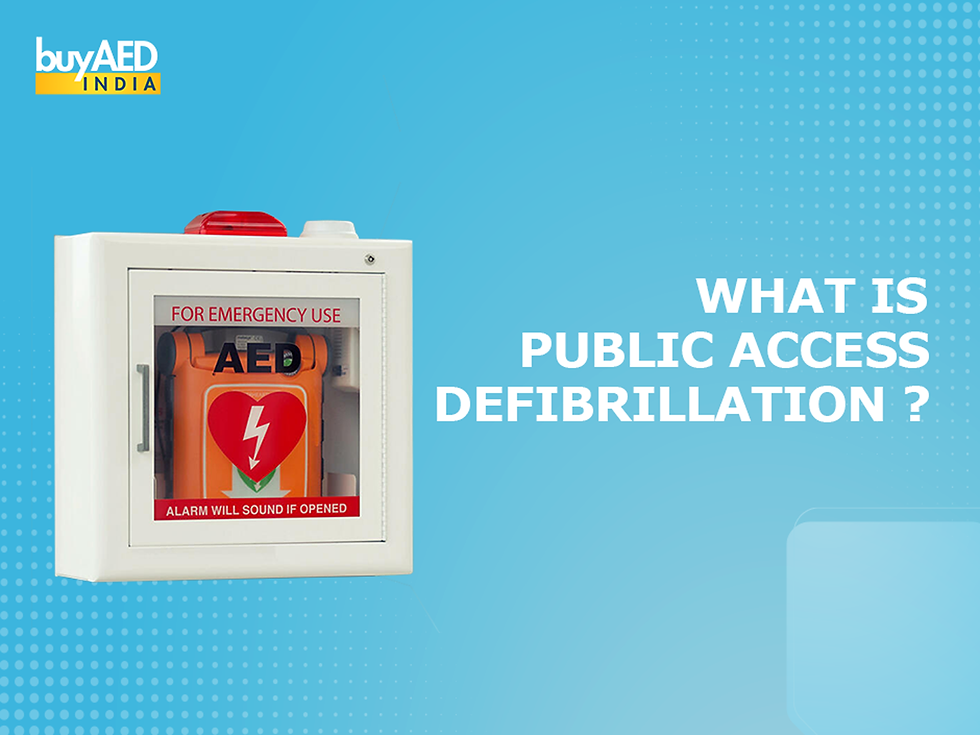When Do You Use a Defibrillator?
- Dr. Shruti Shah

- Aug 1
- 7 min read
Updated: Aug 3

Imagine a person suddenly collapses in a public place on a train or somewhere and people panic.
Nobody knows one thing; however, the clock is ticking, and rescue must be on its way in the shortest possible time.
In most such instances, what you are seeing is Sudden Cardiac Arrest (SCA), which really means the heart suddenly stops beating.
And at such a time a single device may very well be the difference between life and death: a defibrillator.
A defibrillator, in particular, AED (Automated External Defibrillator), is built in such a way that it is supposed to put the person back in a heartbeat by means of the electric shock.
If you're considering buying a defibrillator or want to learn more, explore the Philips HeartStart HS1: a reliable, easy-to-use life-saving device.
Defibrillation needs to be timely each minute that it takes will drop the survival rate of close to 10%. That is why access to AEDs in both public and private areas is not the choice anymore; it is a necessity.
Buy AED India has realized this urgency. They have a good variety of AEDs and accessories to ensure that organizations, homes, and public areas have the distances needed to stand ready.
Here, this blog will address all the information regarding when and how to use defibrillator, who may use it, and how you may use appropriate tools from reliable sources to i.e. Buy AED India.
What Is a Defibrillator and How Does it Work?
A defibrillator is a kind of health care device used in supplying a sudden electric shock to the heart to restore it to its normal rhythm.
This is more so needed in situations such as ventricular fibrillation when the heart is beating uncontrollably or completely stopped.
Automatic external defibrillators (AEDs) used on the general population and manual defibrillators used on trained healthcare professionals in hospitals are the two major types.
AEDs scan the heart rhythm and take the user through a stepwise process of applying a shock in case it is required.
The goal? Establish the normal heart rhythm and have the blood flow through the heart again.
When Should You Use a Defibrillator?
You are advised to apply defibrillator urgently when you suspect an attending person to encounter sudden cardiac arrest (SCA).
SCA is a life-threatening condition in which the heart stops beating efficiently, cutting off blood flow to vital organs like the brain and lungs.
The following are the important symptoms:
Collapse: The individual can fall unexpectedly. This may be the initial event that there is something seriously wrong with their heart.
Unconsciousness: When unconscious, they do not respond to any form of waking up and communicating with them. They will be completely unresponsive to voice or touch.
Not Breathing or Gasping: The individual turns out not to be breathing, or alternatively, he or she may have abnormal gasping breathes that are unproductive in the distribution of oxygen.
No Perceptible Pulse: There is no heartbeat, that means blood is not reaching the brain and other important organs.
During such intense episodes, every second of the time that passes is important. Although CPR (cardiopulmonary resuscitation) is necessary to maintain oxygenated blood flow to the brain and other body organs, CPR would not jump-start the electrical system of the heart.
This is when the defibrillator comes in; it provides a controlled electric shock to the heart which helps sort out the abnormal rhythm and possibly synchronize the regular heartbeat.
Application of an AED is very important once it is available, even when emergency medical services have been attended.
The sooner the defibrillation is used, the more people can survive and minimize the danger of brain damage or death.
Do not hesitate. In case you observe these symptoms, pick up the AED straight away and follow the device instructions as soon defibrillation is lifesaving.
Who Can Use a Defibrillator?

This is the best part, an AED can be operated by anyone. You do not have to be a doctor, nurse, or an EMT.
The AEDs are designed with voice prompts, visual labels as well as clear markings that allow even the bystander with no medical background to use them.
AEDs are made to fit everyone regardless of whether you are a student, teacher, office worker or visiting the gym: AEDs are made to suit any person.
Most of the AEDs listed on Buy AED India are appropriate even in the homes; offices, schools, malls etc. beginner-friendly, reliable.
Never underestimate the value of simple knowledge and confidence because you can become somebody's lifesaver.
Common Scenarios Where AEDs are Needed
When and where cardiac arrest can occur, it is impossible to realize, so AEDs need to be installed in traffic and risky spots.
Among the most common places where AEDs can and should be used are:
Airports, malls, gyms and stadiums
Learning centers, universities and schools
Factories and corporation offices
Houses, particularly for individuals with heart diseases.
Steps to Use a Defibrillator in an Emergency
When an emergency situation occurs, it may make you feel completely overwhelmed to use a defibrillator (AED).
However, most of the current AEDs are intended to be user-friendly and will take you through the whole process.
What you need to do right now is this as soon as you see any person collapse unexpectedly and show symptoms of cardiac arrest:
Step 1: Evaluation of the situation
Determine whether the individual is not breathing or is nonresponsive or gasping. In case they fail to respond, it is an evident emergency.
Step 2: Seek immediate assistance
Call your emergency phone number (here in India 112 or 108) and tell them what happened. Ask another person to make a call in case you are unable to make a call.
Step 3: Switch on the AED
Unzip the AED case and hit the power button. Most AEDs will immediately start giving voice guidance to you.
Step 4: Open chest up and place the pads on it
Take off or remove the clothing to expose your chest. Open the electrode pads to them and put them as precisely indicated in the diagram (one pad over the upper right chest and the other one over the lower left side).

Step 5: Permit the AED to examine the cardiac rhythm
Be sure not to touch the person. The AED will automatically diagnose whether the shock is needed.
Step 6: Deliver the shock if advised
Push the shock button in case the AED encourages you to do so. Be sure people are clear and then administer the shock.
Step 7: Resume CPR
Immediately after the shock is given, start chest compressions.
Perform CPR following the instructions given by the AED until the time of the arrival of the emergency responders or until the time the individual gives up breathing.
The AEDs at Buy AED India are equipped with the voice and screen guidance that is convenient to follow even by an individual with zero medical background.
First time or the tenth, the device does most of the work on its own, it will tell you what to do and you should move fast as they say.
Common Mistakes to Avoid When Using an AED
With good intentions, it is still possible to make some mistakes that will slow down the treatment or decrease the effectiveness of defibrillation.
One thing that is also necessary to understand is what not to do during an emergency:
Do not apply AED pads in clothing. The clothing should be removed, and the chest of the person should be dry and exposed before pads can be placed.
When AED is analyzing heart rhythm or giving a shock, no one should touch the person. The reading can be interrupted by physical contact, which might even be dangerous.
Do not neglect the expiry dates on AED batteries and electrode pads, expired accessories may cause the AED to become ineffective at a time when the situation is critical.
Do not forget to call emergency medical services. AEDs cannot be a substitute which provides professional care. Make sure there is always someone to rescue.
Do not delay CPR while setting up the AED. You should start chest compressions immediately after you have confirmed the cardiac arrest.
Being aware of common errors will save lives! Ensure that your AED is clean, well maintained, and above all change the batteries and pads regularly before the expiry date.
Buy AED India stocks everything you need, back-up and spare supply and all the parts so that you are prepared at any time when every second's matter.
AED Devices & Supplies from Buy AED India
The batteries, pads and accessories of your AED are how effective your AED is.
An effective defibrillator must have equally effective backup, as when things are going bad, there is no time to mess with expired or lost components.
These are some of the necessary AED products within Buy AED India:
Philips Heartstart HS1 Onsite Pads-M5071A: Easily provide appropriate shock delivery
Zoll CPR Stat Pads 8900-0402 : This version comes with CPR feedback to improve performance
Physio Control CR PLUS AED Pads : This model was made to be replaced quickly and comfortably
HeartStart OnSite/Home/FRx Plastic Waterproof Hardshell Case: Waterproof case keeps your AED safe in the event of an impact and the elements
3D AED Signage -Put the location of your AED noticeable in any environment
It is not only smart to have spares but lifesaving. Nobody wants to find out that a battery is dead or a pad is expired when a person needs them the most.
Visit Buy AED India to stock up the guaranteed quality.
Where to buy AED Devices in India?
The above mentioned are all the AEDs that are provided in Buy AED India, a recognized supplier of medical equipment's all over India.
Whether at Hospitals, schools and airports: Buy AED India guarantees:
Original goods inclusive manufacturer warranties.
Nationwide Express Delivery
Brand New AED devices of leading World Brands
Professional Help in the selection of products and compliance
Stay safe, stay ready, shop your AED online at Buy AED India
Conclusion

There are no reminders when the cardiac arrest is at work; the arrest works fast and, in most cases, silently.
That is the reason why CPR knowledge on using a defibrillator can save a life. Wherever you are, whether you are at home, in the office, or at the gym, every second matters since the quicker an AED is used, the better the chance of survival.
Use of an AED is not complicated, and its use is not restricted to any specific person. It is necessary to prepare.
Maintenance of an AED should be functional with a location known to personnel and all parts intact. Such little things make a big difference.
To be ready to act, believe in Buy AED India to obtain authentic defibrillators and spare components and everything that is needed to be ready to rescue people.
Ultimately, it is not only about owning technology, or doing something when nobody cares about you, but also about making a difference, and doing something at the time when something should be done when it matters most.
If you are confused about finding one that offers both quality and affordability, don’t forget to check out defibrillators from Buy AED India, which offers Philips Defibrillators, ZOLL Defibrillators, Cardiac Science Defibrillators, and Defibtech Defibrillators that will meet your needs.





Comments